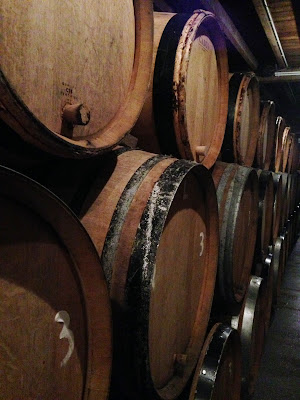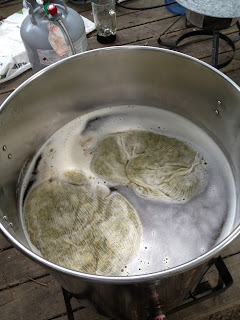I have yet to publish notes on several of my sour beer experiments, so I thought I would give one large update on several works-in-progress. Before leaving for NHC, I tasted all of the batches and recorded notes to reference during my
presentation and to start planning storage and/or fruit additions.
Though I'm grouping them together, I learned (and am still learning) a great deal from each brew. So far, 2 of 5 batches have been dumped, both of which for the same reason:
unpalatable levels of DMS.
DMS can be produced by some wild microorganisms, but I am confident the starchy, corncob-like flavor in these beers was created in the mash tun/kettle. DMS is fairly volatile, but since I did not boil either of these batches, the DMS that formed was not driven off and remained in the finished beer. After boiling half of one of these batches proved effective in removing the off-flavor, I concluded that a full boil is necessary to produce clean beer at the SHPB, especially those with a considerable amount of Pilsner malt.
I specify this necessity is unique to my brewery, as I have read about (and tasted) clean, corncob-free examples of low-gravity, light-colored beers produced without boiling. Perhaps a faster chilling method will make this method a reality for me (I've had my eye on a
Blichmann Therminator for awhile!).
Though no-boil Berliner Weisse (and the like) is a definite possibility, I have also come across numerous commercial and homebrew with high levels of DMS. To significantly reduce the risk of DMS in the finished beer, I recommend boiling as normal. Even a small amount of DMS is perceivable (and overwhelming) in this light and simple style. In the re-boiled batch mentioned, color pickup was minimal, and will be even less in a steam-jacket kettle.
Sour Brown
Split batch of oatmeal brown (the other half was served during our wedding).
Brew Date
|
11/11/12
|
OG
|
1.062
|
Grist
|
16 lbs Rahr 2-row (61.5%)
3 lbs Briess Victory (11.5%)
2 lbs Flaked Oats (7.7%)
2 lbs C-60L (7.7%)
1.75 lbs Pale Chocolate (6.7%)
1.25 lbs Debittered Black Malt (4.8%)
|
Hops
|
35 IBU Apollo (60 min)
|
Primary Yeast
|
N/A
|
Conditioning
|
Inoculated with 3 shots of American Wild Ale (11/11/12)
Pitched 500mL lacto slurry (02/25/13)
Pitched dregs from 3F Gold Blend (early June)
|
Tasting notes:
02/22/13
Very musty, Not much acidity. Drier than the original but
not completely attenuated. Needs a lot more time.
04/19/13
Solid pellicle has formed. Aroma is complex, but still has
some stinky, blue cheese notes. Very tart, with cherry pie, fruity flavors, and
some musty flavors. Thin. Needs another few months.
06/24/13
Chocolatey aroma. Acidity is picking up; a nice level for a
sour brown, with still some residual sweetness at the end of the swallow. There
is astringency, probably from the significant amount of ‘junk’ in the sample –
yeast, trub, pellicle, etc. Maybe a slight alcohol note, but that could be the
combo of the acid and the astringency. OK overall, headed in the right
direction, will continue to age and see what happens.
No-Boil Berliner Weisse
Split batch of Saison wort – this half was taken off after bringing the wort
to boil.
Brew Date
|
02/24/13
|
OG
|
1.056
|
Grist
|
15 lbs Castle Pilsner (68.2%)
6 lbs Flaked Wheat (27.3%)
1 lb Aromatic Malt (4.5%)
|
Hops
|
None
|
Primary Yeast
|
N/A
|
Conditioning
|
Lacto Slurry, mixed culture slurry, Madam Rose 2012 dregs (02/24/13)
|
Tasting notes:
03/06/13
SG = 1.011 (6.0%). Very aromatic. A hint of lemon, but dominated by a nutty
aroma (maybe peanut butter? Also similar to the aroma of UCBC’s Winged Nut).
Prickling acidity, not as forceful as I’d like but very pleasant. Nutty flavors
are also present, some wheat cracker from the wheat. Simple, but extremely
enjoyable already. Great candidate for dry-hopping (Amarillo? Chinook?).
06/24/13
Tasting from keg. Keg was chilled for a period of
time. In that time, tasting revealed ‘nutty’ flavor as DMS
Nutty aroma/flavor (DMS) still present at similar levels to
prior tastings. I don’t believe it will ‘drop out’. It’s a shame – the acidity
level is wonderful. Otherwise a very nice beer.
07/15/13
Dumped keg.
Golden Sour 1 – Double Batch
A double batch (10 gal) of low gravity, malt-based wort. No
boil initially, one half was boiled after primary fermentation to reduce the
(extremely) high levels of DMS. The other half never recovered.
Brew Date
|
03/24/13
|
OG
|
1.043
|
Grist
|
9 lbs Castle Pilsner Malt (47.4%)
9 lbs Rahr Pale Malt (47.4%)
1 lbs Flaked Oats (5.3%)
|
Hops
|
None (Heated to 170F)
|
Primary Yeast
|
A – Lactobacillus (slurry from growler culture), 3711 (after souring)
B – Dregs from No-boil Berliner weisse (before re-boil)
|
Conditioning
|
A – N/A
B – WY3522 (Ardennes), WL644 (Brett Brux Trois) – after sour, boil
|
Fermentation/Tasting notes:
03/29/13
A: No bubbles in airlock throughout the week. SG = 1.021.
White foamy “krausen”. Sample was very cloudy. Very odd aroma, off-putting
(corn stalk - DMS?), carries through in the flavor. Fairly tart, but lacks
tartness of a Berliner Weisse. Not much to it other than that.
B: Bubbled vigorously in airlock for ~ 2 days. SG = 1.030. More corn stalk in flavor and aroma than A. Not nearly as
sour. Aweful.
03/30/13
B: Boiled for 90 minutes (down to 3.1 gal), added whirlfloc
tablet at 15 min left, added 1 gal distilled H2O at KO. Left open to cool to
140F, then covered (flies started to swarm).
04/03/13:
A: Added 1 smack pack 3711 (French Saison)
B: Added 1 smack pack 3522 (Belg Ardennes), Brett Brux Trois
(WL culture), mixed culture
04/10/13
A: SG = 1.010. Still very cloudy, much more so than B (looks
like thin buttermilk). Corncob in the nose, but has diminished and fades more
quickly. Still very tart, and now light on the palate, which leaves less
slickness to carry the corncob flavor. The corn flavor is still there, but in
lesser quantity. Not much else to the flavor. Prickly acidity on the tongue
(more acidic than B, I like this level better). No yeast flavors/aromas.
B: SG = 1.012. Cloudy. Tart, thinner (will be nice with
carbonation). Corny flavor is yielding to a crackery, bready flavor
(graham/saltine?). Acidity is very pleasant, but I believe it would be more so
if further attenuated. The carbonation may give this effect. I’m mostly surprised at the lack of yeast character after
fermentation. Maybe it was because of the low fermentation temp (ambient ~
62F), but I assumed the low pH would stress the yeast and cause some sort of
flavor compound, good or bad.
06/24/13
A: Developed a thin, translucent pellicle in bucket. Flavors
developing but covered up by DMS. Still gross.
B: Formed ¼” thick white, knobby pellicle in carboy. Not
much aroma. Acidity is sharp and lemony, but not much else in terms of flavor.
Fairly clean, with a tiny hint of DMS left. Great candidate for fruit
(especially in the 1/3-full carboy!).
07/14/13: Dumped A
Golden Sour 2
Brew Date
|
04/07/13
|
OG
|
1.060
|
Grist
|
9 lbs Rahr Pale Malt (47.4%)
5 lbs Castle Pilsner Malt (26.3%)
5 lbs Weyermann Wheat Malt (26.3%)
|
Hops
|
None (85 minute boil to reduce DMS)
|
Primary Yeast
|
Lactobacillus (starting at 110F, apple juice/grain starter). Bucket was left in fridge for a few weeks. Developed sharp acidity in 1-2 weeks.
|
Conditioning
|
Wild yeast?
|
Tasting notes:
06/24/13
Developed thin, translucent pellicle (from either wild yeast
in bucket or Lacto starter). Caramel apple aroma. Toasty malt flavor with
sharp, lingering acidity. Hints of apple in aroma/flavor from lacto starter
(made with apple juice). Otherwise
clean. Another great candidate for fruit!
07/14/13
Racked ½ of batch (~2.5 gal) on 6 lbs of whole, pitted
apricots and golden apricots from Farmers Market. Fruit was washed with
luke-warm water before pitting. Added ~ ¼ cup slurry from Cantillion Iris Brett C1 (from
BKYeast) and
mixed starter to fruit portion.
I will most likely add fruit to the (currently) plain portion as well. I have some canned raspberry puree, but I am thinking about adding a comparable amount of canned apricot puree from my LHBS to evaluate the differences of fresh fruit vs. canned puree. More updates to come!





























